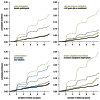Pneumonia in the Noninstitutionalized Older Population
- PMID: 27697144
- PMCID: PMC5290257
- DOI: 10.3238/arztebl.2016.0607
Pneumonia in the Noninstitutionalized Older Population
Abstract
Background: Pneumonia is a common and potentially serious disease, with an incidence of ca. 300 per 100 000 persons per year. Until now, there have been only a few population-based studies of risk factors for pneumonia.
Methods: From 2000 to 2002, nearly 10 000 persons aged 50 to 75 were recruited into the prospective ESTHER cohort study while visiting their family physician for a check-up. The mean duration of follow-up was 10.6 years. Data on newly diagnosed pneumonia were acquired from the participants and their physicians by means of standardized questionnaires. Potential associations with various predictors were studied in survival-time regression models.
Results: 435 participants had pneumonia at least once during follow-up. The cumulative 10-year-incidence was 4.5% (95% confidence interval [4.0; 4.9]). Multiple regression revealed that age (relative risk [RR]: 1.43 [1.22; 1.67] per 10 years), current cigarette smoking (RR: 1.56 [1.19; 2.05], compared with never having smoked), and known congestive heart failure (RR: 1.65 [1.24; 2.20]) were independently associated with an elevated risk of pneumonia. The risk was insignificantly elevated in persons with diabetes mellitus (RR: 1.29 [0.98; 1.68]). Alcohol consumption, obesity, stroke, and cancer were not associated with an elevated risk of pneumonia in age- and sex-adjusted analyses.
Conclusion: Pneumonia plays an important role in the medical care of non-institutionalized older people. With the aid of the predictors identified in this study, primary care physicians can identify patients at risk, smokers can gain additional motivation to quit, treatment compliance can be increased, and patients may become more willing to be vaccinated as recommended in the current guidelines.
Figures

Comment in
-
Community-Acquired Pneumonia-an Underestimated Challenge.Dtsch Arztebl Int. 2016 Sep 16;113(37):605-606. doi: 10.3238/arztebl.2016.0607. Dtsch Arztebl Int. 2016. PMID: 27697143 Free PMC article. No abstract available.
Similar articles
-
Alcohol consumption, smoking, and subsequent risk of colorectal cancer in middle-aged and elderly Japanese men and women: Japan Public Health Center-based prospective study.Cancer Epidemiol Biomarkers Prev. 2003 Dec;12(12):1492-500. Cancer Epidemiol Biomarkers Prev. 2003. PMID: 14693743
-
Gastric cancer risk in relation to tobacco use and alcohol drinking in Kerala, India--Karunagappally cohort study.World J Gastroenterol. 2015 Nov 28;21(44):12676-85. doi: 10.3748/wjg.v21.i44.12676. World J Gastroenterol. 2015. PMID: 26640345 Free PMC article.
-
Risk of heart failure after community acquired pneumonia: prospective controlled study with 10 years of follow-up.BMJ. 2017 Feb 13;356:j413. doi: 10.1136/bmj.j413. BMJ. 2017. PMID: 28193610 Free PMC article.
-
Stroke incidence in women under 60 years of age related to alcohol intake and smoking habit.Cerebrovasc Dis. 2008;25(6):517-25. doi: 10.1159/000131669. Epub 2008 May 15. Cerebrovasc Dis. 2008. PMID: 18480604
-
Declining FEV1 and chronic productive cough in cigarette smokers: a 25-year prospective study of lung cancer incidence in Tecumseh, Michigan.Cancer Epidemiol Biomarkers Prev. 1994 Jun;3(4):289-98. Cancer Epidemiol Biomarkers Prev. 1994. PMID: 8061576
Cited by
-
Community-Acquired Pneumonia in Adults.Dtsch Arztebl Int. 2017 Dec 8;114(49):838-848. doi: 10.3238/arztebl.2017.0838. Dtsch Arztebl Int. 2017. PMID: 29271341 Free PMC article.
-
Rehospitalization for pneumonia after first pneumonia admission: Incidence and predictors in a population-based cohort study.PLoS One. 2020 Jun 30;15(6):e0235468. doi: 10.1371/journal.pone.0235468. eCollection 2020. PLoS One. 2020. PMID: 32603334 Free PMC article.
-
Community-Acquired Pneumonia-an Underestimated Challenge.Dtsch Arztebl Int. 2016 Sep 16;113(37):605-606. doi: 10.3238/arztebl.2016.0607. Dtsch Arztebl Int. 2016. PMID: 27697143 Free PMC article. No abstract available.
-
Role of lifestyle factors on the development and long-term prognosis of pneumonia and cardiovascular disease in the Chinese population.Chin Med J (Engl). 2025 Jun 20;138(12):1456-1464. doi: 10.1097/CM9.0000000000003160. Epub 2024 Aug 28. Chin Med J (Engl). 2025. PMID: 39193696 Free PMC article.
-
Incidence of pneumonia in nursing home residents in Germany: results of a claims data analysis.Epidemiol Infect. 2018 Jul;146(9):1123-1129. doi: 10.1017/S0950268818000997. Epub 2018 Apr 26. Epidemiol Infect. 2018. PMID: 29695311 Free PMC article.
References
-
- Welte T. Community-acquired pneumonia: a disease of the elderly. Z Gerontol Geriatr. 2011;44:221–228. - PubMed
-
- Pletz MW, Ewig S, Lange C, Welte T, Höffken G. [Update pneumonia 2012] Dtsch Med Wochenschr. 2012;137:2265–2280. - PubMed
-
- Eurich DT, Marrie TJ, Minhas-Sandhu JK, Majumdar SR. Ten-year mortality after community-acquired pneumonia A prospective cohort. Am J Respir Crit Care Med. 2015;192:597–604. - PubMed
MeSH terms
LinkOut - more resources
Full Text Sources
Other Literature Sources
Medical

